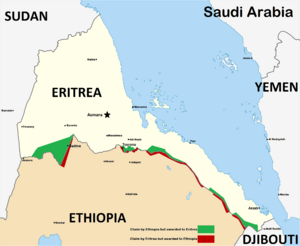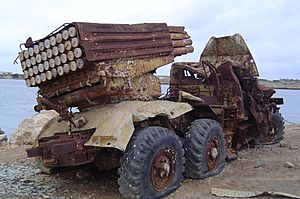Eritrean–Ethiopian War facts for kids
Quick facts for kids Eritrean–Ethiopian War |
|||||||||
|---|---|---|---|---|---|---|---|---|---|
| Part of the Eritrean–Ethiopian border conflict | |||||||||
 Map of the disputed territories on the Eritrea–Ethiopia border where vast majority of the fighting took place |
|||||||||
|
|||||||||
The Eritrean–Ethiopian War, also known as the Badme War, was a big armed conflict between Ethiopia and Eritrea. It happened from May 1998 to June 2000.
Eritrea became independent from Ethiopia in 1993. At first, the two countries were friendly. But soon, they disagreed about where their new international border should be. This disagreement made their relationship much worse, leading to a full-scale war. An international group later said Eritrea started the war by invading Ethiopia in 1998.
By 2000, Ethiopia had taken control of all the areas they were fighting over. They had also moved into Eritrea. The war officially ended when the Algiers Agreement was signed on December 12, 2000. However, the border conflict continued for almost twenty more years.
Both Eritrea and Ethiopia spent a lot of money on weapons before the war. Sadly, between 70,000 and 300,000 people from both sides died because of the war. Many people also became refugees, meaning they had to leave their homes. After the war, a special group decided that Badme, the main disputed area, belonged to Eritrea. In 2018, Ethiopia's Prime Minister, Abiy Ahmed, agreed to fully follow the peace treaty. Both countries declared peace in July 2018, twenty years after the fighting began.
Contents
Why the War Started
From 1961 to 1991, Eritrea fought a long war to become independent from Ethiopia. During this time, the Ethiopian Civil War also began in Ethiopia in 1974. Both conflicts ended in 1991. At that time, a group called the Ethiopian People's Revolutionary Democratic Front (EPRDF) took over the government in Ethiopia.
During the civil war, the EPRDF worked with the Eritrean People's Liberation Front (EPLF). They were allies because they both fought against the old Ethiopian government. In 1991, it was agreed that Eritrea would hold a vote to decide its future. This vote happened in April 1993, and most people voted for independence. This led to Eritrea becoming a new country and joining the United Nations.
After Eritrea became independent, both governments agreed to set up a group to solve any problems between them. But this group did not succeed. Over the next few years, the relationship between the two countries got worse. Eritrea even started forcing Ethiopians to leave its territory. Many of these people had lived in Eritrea for a long time.
The Border Problem
Deciding the exact border between Eritrea and Ethiopia became a big problem. Before Eritrea's independence, the border was not very important. It was just a line between different parts of the same country. At first, both governments quietly agreed to keep the border as it was.
But once Eritrea became a separate country, the border became an international line. The two governments could not agree on where the border should be. They looked at old treaties from when Italy ruled Eritrea to try and figure it out. However, they disagreed on how to understand these old agreements. It was also unclear if these old treaties were still valid for the new countries.
The War Begins
First Attacks: May 1998 – February 1999
There were some small armed fights where Eritrean officials were killed near Badme. Then, on May 6, 1998, a large Eritrean army entered the Badme area. This led to a fight between Eritrean soldiers and Ethiopian police and local fighters.
On May 13, 1998, Ethiopia gathered its forces for a full attack on Eritrea. This meant that a state of war officially existed between the two countries. The fighting quickly grew, with artillery and tank fire. The Ethiopian Air Force attacked the airport in Asmara, Eritrea's capital. Eritrean forces also attacked the airport in Mekele, Ethiopia. These attacks hurt and killed people on both sides. The United Nations asked both sides to stop the air attacks.
After this, there was a quiet period. Both countries gathered huge armies along their border and dug many trenches. They spent hundreds of millions of dollars on new military equipment. During this time, other countries tried to help them make peace. The United States and Rwanda suggested a peace plan. It asked both armies to go back to where they were before June 1998. Eritrea refused this plan. Instead, Eritrea wanted all disputed areas to be without soldiers, watched by a neutral group, and for direct talks to happen.
Big Battles: February 1999 – May 2000
Because Eritrea did not accept the peace plan, Ethiopia launched a huge military attack on February 22, 1999. Their goal was to take back Badme. Ethiopian General Samora Yunis famously said about the Eritrean trenches, "The Eritreans are good at digging trenches and we are good at converting trenches into graves."
Ethiopia's attack, called Operation Sunset, started with air attacks on Assab airport. Then, there was a massive artillery attack on Eritrean positions. The next day, Ethiopian ground troops attacked. They broke through Eritrean defenses and surprised the Eritrean army. The Eritrean soldiers in the Badme area quickly retreated, leaving behind their defenses and heavy weapons. Ethiopian helicopters attacked the fleeing Eritreans.
After five days of heavy fighting, Ethiopian forces were deep inside Eritrea. Eritrea then accepted the peace plan on February 27, 1999. Even though both countries said they accepted the plan, Ethiopia did not stop its advance right away. Ethiopia wanted Eritrea to leave all the areas it had taken since the war began. Both sides used a lot of trench warfare, which is like the fighting in World War I. This type of fighting led to many young lives being lost.
In May 1999, Ethiopia attacked again. The fighting continued in June 1999, with both sides dug into their positions.
Final Push: May – June 2000
Peace talks broke down in early May 2000. Ethiopia said Eritrea was making "unacceptable conditions." On May 12, Ethiopia launched another massive attack with many tanks, infantry, and air support. The Ethiopians used donkeys to carry supplies for their soldiers. They mostly used infantry attacks to capture Eritrean positions, keeping their tanks for later.
Ethiopian forces broke through Eritrean lines and cut off a main supply road for Eritrean troops. On May 16, Ethiopia said its aircraft attacked targets and that heavy ground fighting continued. The next day, Ethiopian ground forces captured more areas. They took Barentu in a surprise attack. Because of the ongoing fighting, the United Nations placed an arms embargo on both countries. This meant they could not buy new weapons.
By May 23, Ethiopia claimed its troops had taken important command posts near Zalambessa. Eritrea said it pulled back from Zalambessa and other disputed areas as a "goodwill gesture" to restart peace talks. They called it a "tactical retreat." Ethiopia declared the war was over on May 25, 2000, after taking back most of the disputed areas.
End of Fighting
On June 18, 2000, both sides agreed to a full peace agreement. They also agreed to let a neutral group settle their disagreements. On July 31, 2000, the United Nations set up a 25-kilometer-wide safe zone inside Eritrea. This zone was patrolled by UN peacekeepers from over 60 countries. A final peace agreement was signed on December 12, 2000.
What Happened After the War
People Lost
Eritrea officially said that 19,000 Eritrean soldiers died in the war. Ethiopia claimed to have lost between 34,000 and 60,000 soldiers. Some reports suggest the total number of deaths from both sides could be around 70,000. However, some people in the region believe the total death toll might have been as high as 300,000.
How the War Was Fought
Eritrea accused Ethiopia of using "human waves" to attack their trenches. This means sending many soldiers forward at once, even if it means many will die. But reports from The Independent newspaper said there were no "human waves." Instead, Ethiopian troops outsmarted and overpowered the Eritrean trenches.
Money Problems
Both countries already had weak economies from many years of conflict and drought. The war made these problems much worse, leading to food shortages. Before the war, Eritrea and Ethiopia traded a lot with each other. Ethiopia also used Eritrean roads and ports for its international trade.
Ethiopia started a program to help over 148,000 soldiers who fought in the war return to normal life. This program cost $174 million. Ethiopia could only pay a small part of this and had to borrow $170 million from the World Bank.
Spreading Conflict
The fighting also spread to Somalia. Both governments tried to gain an advantage over the other. Eritrea supported a rebel group in Somalia that wanted independence from Ethiopia. In return, Ethiopia supported groups in Somalia that were against Eritrea's allies. Ethiopia also restarted relations with Sudan, which was accused of supporting groups attacking Eritrea. Ethiopia also supported various Eritrean rebel groups.
The Border Decision
On April 14, 2002, the Eritrea–Ethiopia Boundary Commission made its "final and binding" decision. This group was set up under the Algiers Agreement. The decision gave some land to each side. But importantly, Badme, the place where the conflict started, was given to Eritrea.
One expert, Martin Pratt, wrote that when it became clear Badme was given to Eritrea, Eritreans were very happy. Ethiopians, however, were very upset. Even though Badme was a small village with no clear importance, it had become a huge symbol during the war. For many people in both countries, the fate of Badme showed if the many lives lost during the fighting were worth it.
Images for kids
See also
 In Spanish: Guerra entre Etiopía y Eritrea para niños
In Spanish: Guerra entre Etiopía y Eritrea para niños
- Tigray War



